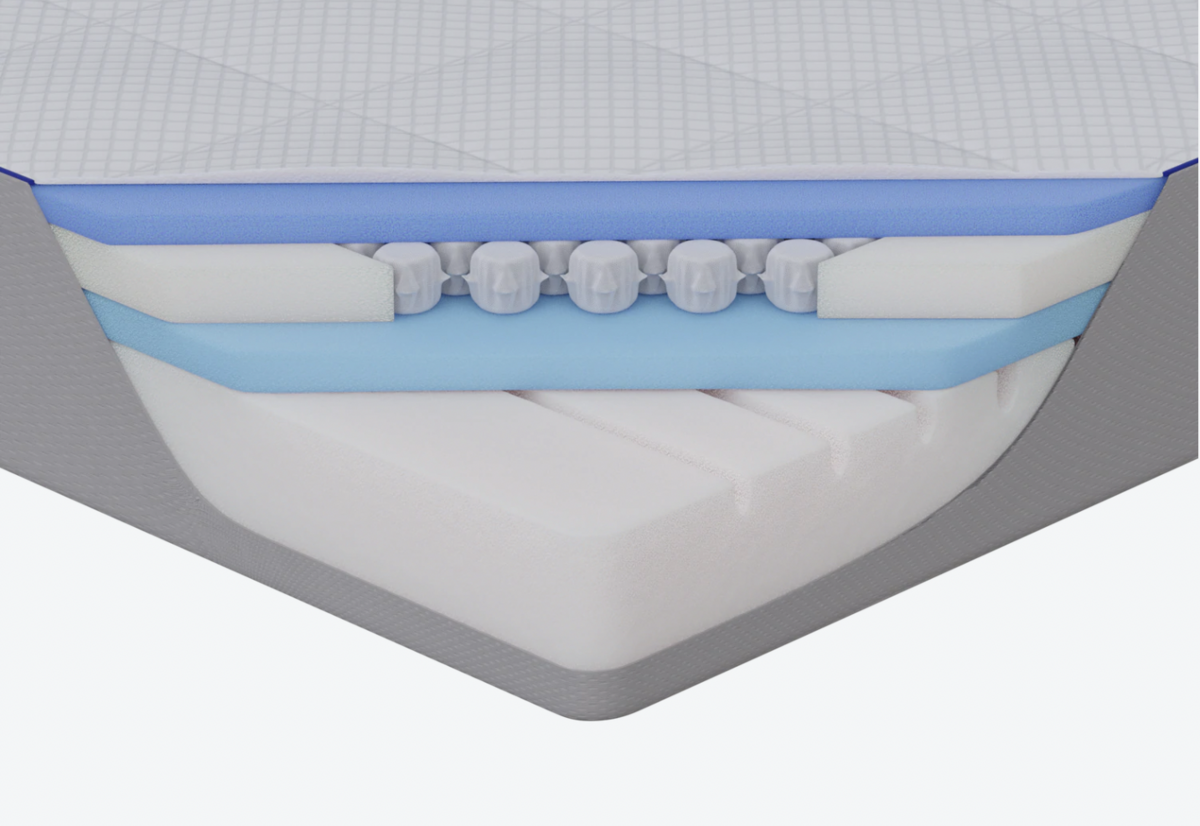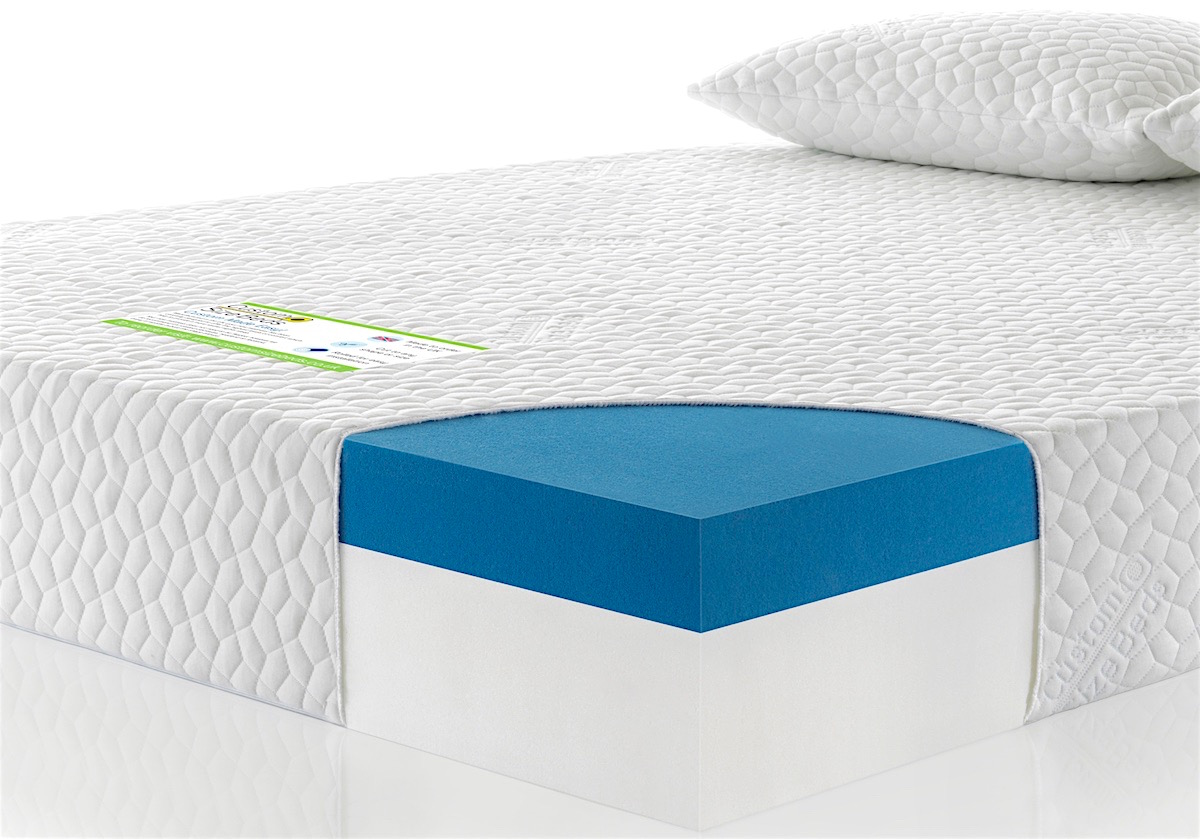Are you a hot sleeper looking for a cushioned and breathable mattress? Maybe you’re torn between a hybrid and a gel memory foam mattress?
These two types are often considered the best mattress choice for hot sleepers. And why is that? They have properties that prevent heat retention, help with dissipation and effectively regulate your body temperature.
But what’s the difference between the two? Besides breathability, more factors come into play when buying a mattress, such as:
- Motion transfer
- Noise
- Cost
- Sleeping position
- Bodyweight
Not considering these can make you buy the wrong mattress and suffer years of not-so-quality sleep.
In a 2020 consumer report, “a good night’s sleep” was rated as the most crucial factor in overall health and well-being. And the goal of this guide is to take you one step closer to that.
We’ll provide a detailed comparison between hybrid and gel memory foam mattresses, their pros and cons, and answer common questions our readers have.
What is a hybrid mattress?

If you’re wondering what a hybrid mattress is, it combines multiple layers of foam as the comfort layer and a spring system as the support core.
- The comfort layer is usually memory, gel memory, or latex foam. All of them provide cushioning and pressure relief, with gel providing additional coolness.
- The support layer is composed of springs, either pocket or open coils. This provides breathability, support, edge support, and is responsive to your movement.
Advantages of a hybrid mattress
So, what are the advantages of using a hybrid mattress, and why may you want mixed components and materials rather than a singular one?
- Breathable – the spring layer provide additional breathability and help dissipate the heat from your body through improved airflow. If you have too hot a body core temperature can have a significant impact on sleep calmness, satisfaction and adequateness and cause difficulty falling asleep.
- Good Support Throughout Including Edge Support – the springs provide strong support throughout the mattress’s surface, including the edges. Whereas gel memory foam still suffers from traditional memory foam’s problem of sinking too much. Great for plus-sized, back, and stomach sleepers.
- Ease Of Movement – the responsive springs won’t make you feel like being stuck in bed compared to memory foam. This results in them being better for combo sleepers or plus-sized people as they can move between positions easily.
Disadvantages of a hybrid mattress
But not all is positive about a hybrid mattress. These are the disadvantages of the hybrid mattress.
- Motion Transfer And Noise – The springs contribute to increase motion transfer within the bed. This is bad news for people sharing a bed, as you can feel your partner’s movements. Cheaply made springs can shorten a hybrid mattress lifespan as well as problems like squeaking, less responsiveness and a lumpy mattress.
- Cost – The spring and multiple foam layers contribute to the high cost of hybrid mattresses. They typically cost around £700 for a king-sized mattress. This is higher when compared to a king-sized gel mattress which costs around £500.
- Heavy – Because of the spring and multiple layers of foam on a hybrid mattress, foam layers can be pretty heavy, weighing an average of 50 kg. This might inconvenience people living alone who need to move the bed.
What is a gel memory foam mattress?

A gel memory foam mattress integrates modern technologies to address the heat retention problem of traditional memory foam. Traditional memory foam uses your body’s heat to soften and mould the body’s curves, and while this hugging sensation may feel good there’s no way for this heat to escape.
Gel memory foams use synthetic phase-changing materials (PCM) infused into the polyurethane foam. This helps regulate body temperature by:
- absorbing excess heat from the body and storing that heat, and
- releasing stored heat to the body if the body temperature drops
It is called “phase-changing” because the gel changes from a solid to a liquid as it absorbs body heat and from a liquid to a solid as it releases body heat.
Advantages of a Gel Memory Foam Mattress
These are the pros of using a gel memory foam mattress. It might convince you to buy one.
- Cooling – one of the main differences between memory foam and gel-infused foam is that gel provides a cooler sleep environment and helps regulate your body temperature. Aside from being good news for hot sleepers, a study found that impaired thermoregulation increases wakefulness at night, especially when your body heat is trapped and can’t dissipate.
- Motion Isolation – since gel memory foam still has the properties of memory foam it means that it has superior shock-absorbing properties over hybrids with springs. As the foam conforms around your body, it isolates motion and helps people who wake up due to their partner’s movements.
- Pressure Relief – gel memory foam helps cushion the joints. It relieves pressure on body parts such as the shoulders and hips by contouring the body’s curves in contact. This property also benefits side sleepers as it helps keep a neutral spinal alignment.
Disadvantages of a gel memory foam mattress
Depending on your sleeping preferences and environment, there are some cons to gel memory foam.
- Sinking Feeling – Gel provides contouring and hugging comfort that may also feel like a sinking or stuck feeling for heavier people, resulting in it being harder to move. And if you’re the type to change positions at night, this feature might be a problem for you.
- Lack Of Edge Support – unlike a hybrid mattress with spring support on the perimeter of the mattress, gel memory foam would have to rely on foam firmness for edge support.
- Temporary Cooling – the PCM gels will only absorb and dissipate heat until the temperature between the body and the foam is the same. Some users report that the cooling effect of the gel memory foam is temporary, or they only felt it at the beginning of their sleep.
Here’s a visual breakdown of the pros and benefits of each mattress type covered. Make sure to save the image so you can come back to it in the future
Hybrid Mattress vs. Gel Memory Foam Mattress
Here’s a visual breakdown of the pros and benefits of each mattress type covered. Make sure to save the image so you can come back to it in the future.

What Are The Differences Between Gel Memory Foam And Hybrids?
We’ve tested dozens of both mattress types and these are what we consider to be top 6 biggest differences:
- Support system: Gel memory foam mattresses use foam as the main support structure, while hybrids use a combination of foam and springs.
- Firmness level: Gel is typically softer and provide more pressure relief, while hybrids are more responsive and feel firmer but offer more support.
- Motion isolation: Gel memory foam is the winner here as springs in a hybrid result in feeling more movement across the mattress.
- Durability: Hybrid mattresses tend to be more durable as the coils are more resistant to wear and tear, especially if they’re pocket springs.
- Price: Gel memory foam mattresses are generally less expensive than hybrids, but as always, the price will vary on the brand and material quality.
- Temperature control: Gel memory foam mattresses are designed to absorb and distribute heat, making them cooler to sleep on. Although, there are hybrids that integrate gel foam too.
Who Are Hybrid Mattresses Best For?
If you can relate to one or two of the situations below, a hybrid mattress might be perfect for you.
You need a supportive mattress.
You need a mattress that doesn’t feel like you’re stuck in bed.
You need a mattress with strong edge support.
With that, here are some of the best hybrid mattress recommendations:
Nectar Hybrid Mattress
Simba Hybrid Mattress
Who Are Gel Memory Foam Mattresses Best For?
If you can relate to one or two of these situations, gel foam might be right mattress for you:
You need a body contouring mattress
You need a mattress that isolates motion,
ou need a mattress that is quiet and not squeaky.
With that, here are some best memory foam mattress recommendations:
Studio by Silentnight Original Mattress
Inofia Mattress
Happy Beds Ocean Gel
Still can’t decide? You can buy a hybrid mattress with a gel top layer instead, like this one from TheraPur. Get the best of both hybrid mattresses and gel in one!
Which Is Softer: Gel Memory Foam or Hybrids?
A gel memory foam is generally considered to be softer than hybrids as they’re designed to contour to your body and provide relief to pressure points. Hybrids normally have a firmer feel as their spring support system provides more responsiveness.
Which Lasts Longer Between Gel Memory Foam and Hybrids?
A hybrid mattress lasts longer than gel memory foam because of their spring support system providing more support to the foam comfort layer. Pure foam mattresses tend to have shorter lifespans because they sag easily.
Are Hybrid Mattresses Good For Back Pain?
Yes, a hybrid mattress can be good for back pain. Most come as medium-firm rating which studies concluded as the best firmness to alleviate back pain. Hybrids contain the best of both worlds from spring and foam mattresses but ultimately firmness will depend on your body weight and sleeping position.
Does A Hybrid Mattress Need A Box Spring?
No, a hybrid mattress does not need a box spring as it can efficiently absorb shock with the foam layers and is breathable because of the spring support.
A boxspring is used to:
– Help absorb shock from the mattress, especially an innerspring mattress
– Provides a foundation for the mattress
– Add height to the mattress
– Allow proper ventilation to the mattress
How Long Does It Take To Break In A Hybrid Mattress?
Mattress brands like Emma offer a 200-night mattress trial period and claim that it takes around 6 weeks to fully break-in to a new mattress.
However, some manufacturers like Nectar only allow returns after the 30-day Adjustment Period.
6 Sources
- Mattress Shopper’s Buyer Journey. (2020, February). Retrieved from International Sleep Products Association:
https://sleepproducts.org/resources/consumer-research/ - Zheng, G., Li, K., & Wang, Y. (2019, January). The Effects of High-Temperature Weather on Human Sleep Quality and Appetite. Retrieved from National Center for Biotechnology Information:
https://www.ncbi.nlm.nih.gov/pmc/articles/PMC6351950/ - Lack, L. C., Gradisar, M., Someren, E. J., Wright, H. R., & Lushington, K. (2008, August). The relationship between insomnia and body temperatures . Retrieved from National Center for Biotechnology Information:
https://pubmed.ncbi.nlm.nih.gov/18603220/ - Hailey, L., Roberts, N., Spurden, D., Wray, J., & Burls, A. (2016, November). Mattress type for improving outcomes for chronic low-back pain: a systematic review . Retrieved from Research Gate:
https://www.researchgate.net/publication/311237287_Mattress_type_for_improving_outcomes_for_chronic_low-back_pain_a_systematic_review - Marin, R., Cyhan, T., & Miklos, W. (2006, May). Americal Journal of Physical Medicine & Rehabilitation. Retrieved from Sleep Disturbance in Patients With Chronic Low Back Pain:
https://journals.lww.com/ajpmr/Abstract/2006/05000/Sleep_Disturbance_in_Patients_With_Chronic_Low.3.aspx - Kovacs, F. M., Abraira, V., Peña, A., Martín-Rodríguez, J. G., Sánchez-Vera, M., Ferrer, E., . . . Mufraggi, N. (2003, November 15). Effect of firmness of mattress on chronic non-specific low-back pain: randomised, double-blind, controlled, multicentre trial. Retrieved from National Center for Biotechnology Information:
https://pubmed.ncbi.nlm.nih.gov/14630439/






